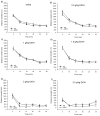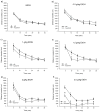Glyoxalase 1 (GLO1) Inhibition or Genetic Overexpression Does Not Alter Ethanol's Locomotor Effects: Implications for GLO1 as a Therapeutic Target in Alcohol Use Disorders
- PMID: 29532486
- PMCID: PMC5915917
- DOI: 10.1111/acer.13623
Glyoxalase 1 (GLO1) Inhibition or Genetic Overexpression Does Not Alter Ethanol's Locomotor Effects: Implications for GLO1 as a Therapeutic Target in Alcohol Use Disorders
Abstract
Background: Glyoxalase 1 (GLO1) is an enzyme that metabolizes methylglyoxal (MG), which is a competitive partial agonist at GABAA receptors. Inhibition of GLO1 increases concentrations of MG in the brain and decreases binge-like ethanol (EtOH) drinking. This study assessed whether inhibition of GLO1, or genetic overexpression of Glo1, would also alter the locomotor effects of EtOH, which might explain reduced EtOH consumption following GLO1 inhibition. We used the prototypical GABAA receptor agonist muscimol as a positive control.
Methods: Male C57BL/6J mice were pretreated with either the GLO1 inhibitor S-bromobenzylglutathione cyclopentyl diester (pBBG; 7.5 mg/kg; Experiment 1) or muscimol (0.75 mg/kg; Experiment 2), or their corresponding vehicle. We then determined whether locomotor response to a range of EtOH doses (0, 0.5, 1.0, 1.5, 2.0, and 2.5) was altered by either pBBG or muscimol pretreatment. We also examined the locomotor response to a range of EtOH doses in FVB/NJ wild-type and transgenic Glo1 overexpressing mice (Experiment 3). Anxiety-like behavior (time spent in the center of the open field) was assessed in all 3 experiments.
Results: The EtOH dose-response curve was not altered by pretreatment with pBBG or by transgenic overexpression of Glo1. In contrast, muscimol blunted locomotor stimulation at low EtOH doses and potentiated locomotor sedation at higher EtOH doses. No drug or genotype differences were seen in anxiety-like behavior after EtOH treatment.
Conclusions: The dose of pBBG used in this study is within the effective range shown previously to reduce EtOH drinking. Glo1 overexpression has been previously shown to increase EtOH drinking. However, neither manipulation altered the dose-response curve for EtOH's locomotor effects, whereas muscimol appeared to enhance the locomotor sedative effects of EtOH. The present data demonstrate that reduced EtOH drinking caused by GLO1 inhibition is not due to potentiation of EtOH's stimulant or depressant effects.
Keywords: GABAA; Anxiety-Like Behavior; Ethanol; Glyoxalase 1; Locomotor Activity.
Copyright © 2018 by the Research Society on Alcoholism.
Figures








Similar articles
-
Pharmacological and genetic manipulation of glyoxalase-1 (GLO1) does not alter locomotor responses or conditioned place preference induced by cocaine or oxycodone.Pharmacol Biochem Behav. 2025 Aug;253:174040. doi: 10.1016/j.pbb.2025.174040. Epub 2025 May 22. Pharmacol Biochem Behav. 2025. PMID: 40412584 Free PMC article.
-
Genetic and pharmacological manipulation of glyoxalase 1 regulates voluntary ethanol consumption in mice.Addict Biol. 2017 Mar;22(2):381-389. doi: 10.1111/adb.12333. Epub 2015 Dec 22. Addict Biol. 2017. PMID: 26691867 Free PMC article.
-
Investigating the Role of Glyoxalase 1 as a Therapeutic Target for Cocaine and Oxycodone Use Disorder.bioRxiv [Preprint]. 2024 Dec 23:2024.12.23.630123. doi: 10.1101/2024.12.23.630123. bioRxiv. 2024. PMID: 39763915 Free PMC article. Preprint.
-
Emerging Glycation-Based Therapeutics-Glyoxalase 1 Inducers and Glyoxalase 1 Inhibitors.Int J Mol Sci. 2022 Feb 23;23(5):2453. doi: 10.3390/ijms23052453. Int J Mol Sci. 2022. PMID: 35269594 Free PMC article. Review.
-
Glo1 inhibitors for neuropsychiatric and anti-epileptic drug development.Biochem Soc Trans. 2014 Apr;42(2):461-7. doi: 10.1042/BST20140027. Biochem Soc Trans. 2014. PMID: 24646261 Free PMC article. Review.
Cited by
-
Inhibition of Glyoxalase 1 reduces alcohol self-administration in dependent and nondependent rats.Pharmacol Biochem Behav. 2018 Apr;167:36-41. doi: 10.1016/j.pbb.2018.03.001. Epub 2018 Mar 2. Pharmacol Biochem Behav. 2018. PMID: 29505808 Free PMC article.
-
Pharmacological and genetic manipulation of glyoxalase-1 (GLO1) does not alter locomotor responses or conditioned place preference induced by cocaine or oxycodone.Pharmacol Biochem Behav. 2025 Aug;253:174040. doi: 10.1016/j.pbb.2025.174040. Epub 2025 May 22. Pharmacol Biochem Behav. 2025. PMID: 40412584 Free PMC article.
-
A mutant allele of glycoprotein M6-B (Gpm6b) facilitates behavioral flexibility but increases delay discounting.Genes Brain Behav. 2022 Apr;21(4):e12800. doi: 10.1111/gbb.12800. Epub 2022 Mar 3. Genes Brain Behav. 2022. PMID: 35243767 Free PMC article.
-
Fentanyl-induced acute and conditioned behaviors in two inbred mouse lines: Potential role for Glyoxalase.Physiol Behav. 2022 Jan 1;243:113630. doi: 10.1016/j.physbeh.2021.113630. Epub 2021 Oct 26. Physiol Behav. 2022. PMID: 34710466 Free PMC article.
-
Methylglyoxal in the Brain: From Glycolytic Metabolite to Signalling Molecule.Molecules. 2022 Nov 15;27(22):7905. doi: 10.3390/molecules27227905. Molecules. 2022. PMID: 36432007 Free PMC article. Review.
References
-
- Aguayo LG, Peoples RW, Yeh HH, Yevenes GE. GABA(A) receptors as molecular sites of ethanol action. Direct or indirect actions? Current Topics in Medicinal Chemistry. 2002;2(8):869–885. - PubMed
-
- Arnt J, Scheel-Krüger J, Magelund G, Krogsgaard-Larsen P. Muscimol and related GABA receptor agonists: the potency of GABAergic drugs in vivo determined after intranigral injection. Journal of Pharmacy and Pharmacology. 1979;31(1):306–313. https://doi.org/10.1111/j.2042-7158.1979.tb13506.x. - DOI - PubMed
-
- Boyce-Rustay JM, Cameron HA, Holmes A. Chronic swim stress alters sensitivity to acute behavioral effects of ethanol in mice. Physiology & Behavior. 2007;91(1):77–86. https://doi.org/10.1016/j.physbeh.2007.01.024. - DOI - PubMed
-
- Camarini R, Hodge CW. Ethanol preexposure increases ethanol self-administration in C57BL/6J and DBA/2J mice. Pharmacology Biochemistry and Behavior. 2004;79(4):623–632. https://doi.org/10.1016/j.pbb.2004.09.012. - DOI - PubMed
-
- Castro CA, Hogan JB, Benson KA, Shehata CW, Landauer MR. Behavioral effects of vehicles: DMSO, ethanol, Tween-20, Tween-80, and emulphor-620. Pharmacology, Biochemistry, and Behavior. 1995;50(4):521–526. - PubMed
Publication types
MeSH terms
Substances
Grants and funding
LinkOut - more resources
Full Text Sources
Other Literature Sources
Molecular Biology Databases
Research Materials
Miscellaneous

